Remember when MANA refused to change their practice guidelines in light of their own research that showed home birth to be incredibly dangerous for high risk pregnancies? It turns out MANA will change their guidelines, just not in a way that has anything to do with the safety of mothers or babies. They have recently made the change of removing the word “woman” and replacing it with “pregnant individual”. If you had assumed they were too lazy to change their documents you were wrong, they simply don’t care if you or your child dies in a home birth. Anything for “the cause” of birth at home, I suppose.
Home Birth fatalities- a growing trend in Hawaii
Is Home Birth Safe? is a new blog about home birth safety, and they found an article about the trend of home births (and subsequent, preventable fatalities) in Hawaii:
“One obstetrician said that Wednesday’s death had taken a toll on hospital staff, especially because of the fact that it was another in a disturbing trend.”
“’This is an ongoing problem here. … Within the last five years, I’ve seen at least three dead babies from home births, and just a week ago I took care of a patient who nearly bled to death after a home birth,’ the doctor said. ‘All of the obstetricians here have had similar experiences. And in all of these situations, the standard of care of obstetric practice was not followed by the practitioners. I believe that all of these bad outcomes could have been avoided if good practice patterns were actually followed.’”
Does your midwife have blood on her hands?
Many home birth midwives have the nerve to crowd source their patient care decisions online, and in one known case a child died as a result. Gavin Michael died after Jan Tritten, editor of the trade magazine Midwifery Today (and a former midwife herself), helped another midwife (Christy Collins CPM) crowdsource a post dates baby with zero amniotic fluid.
The thread was captured online and saved to a word document, but its contents are not found by search engines. I thought I would do the world a favor and put the name and location of each person complacent in this death up on this blog, where prospective clients can find it and perhaps question these women about their role in Gavin Michael’s death. This is also an opportunity for anyone listed to take responsibility for their role. If you want to search this post press control and the F key at the same time and type your midwife’s name. I’m doing my best to only post information I can trace directly back to the facebook thread but I’m only human, so if you notice a mistake feel free to leave a comment and I will investigate/issue retractions as needed. I am posting their pictures in case any of them decide to change their name or go by a different name- its common in the home birth industry to do so in order to evade responsibility.
First up is the midwife that sent the question, Christy Collins CPM (who was prosecuted in California and then moved to Nevada in order to avoid regulation)
I would list Jan Tritten but she is no longer practicing (thank god).
The first comment on facebook encouraging Christy to forgo medical intervention is from Wanda Smith, LDEM CPM from Virginia. Here is her comment and photo:
 “absolutely no experience with “0″ fluid, but have had two go quite over with very low fluid (under 5), one was 18 days over, quite uneventful home birth, and one was 19 days over with heavy mec and true knot, that did give a us a little trouble, but she stilled birthed vaginally”
“absolutely no experience with “0″ fluid, but have had two go quite over with very low fluid (under 5), one was 18 days over, quite uneventful home birth, and one was 19 days over with heavy mec and true knot, that did give a us a little trouble, but she stilled birthed vaginally”
From what I can tell this is all illegal for licensed midwives in the state of Virginia. You can find her info at Gentle Birth Roanoke. WANDA SMITH, you have blood on your hands. You played with your patient’s life and instead of counting yourself lucky for having live babies and mothers you encouraged another midwife to play your game. Shame on you for bragging about risking patients lives and well being.
Next is Sharon Schlicher, Oklahoma “tradional” Midwife. She routinely posts from a facebook account for Thomas McGregor but signs all her posts and all of them appear to be the same person. Here is her advice for the family of the (now deceased) baby in clear medical danger:
I caught a baby with zero amniotic fluid years ago before routine ultrasounds. She did have membranes that HAD to be broken, they were incredibly tough, that’s how I know she had zero water. Birth was uneventful but baby had a major birth defect and was referred to children’s hospital for eval and surgery. Sharon Schlicher, Oklahoma Midwife
She works at Spirit Within Homebirth Services. They do not have website however so she may not be working under that company name for long.
Christy Fiscer, lay midwife, of Ivins Utah had this to say:
Fluid level readings can, and often are highly inaccurate at this point… yet often used now as indication for intervention. Can you FEEL fluid during palpation, or does baby have a “plastic wrapped” feel?
Just had a friend diagnosed with ZERO fluid, yet somehow had plenty when SROM took place less than 2 days later.
When I was looking for her picture I found a post of hers asking other midwives advice on attending high risk out of hospital births. She learned nothing from participating in this preventable tragedy. She works at Birthkeeper midwifery in utah. Shame on you for not recommending immediate transport and monitoring of a baby experiencing medically emergent issues.
Del Balgas, California based Lm Cpm proves that the certification process for non-nurse midwives is useless. Look at her comment about the emergency:
I had this happen not low fluid no fluid . Where did it go?
Why should she be allowed to deliver babies if she doesn’t know where amniotic fluid “goes”? I am glad she was honest enough to admit that she didn’t know any answers, but I wish she were honest enough with herself about her qualifications to stop delivering babies.
She is able to practice in California and Arizona.
Alison Reid, a midwife from Australia, said this:
There is evidence to say that AFIs are often inaccurate. Is the baby moving well? Can the outline of the baby be seen clearly (which can mean little liquor)? Could the mother be leaking fluid and unaware (it happens). If baby is happy, get her to take precautions against infection and wait. I would listen to the mother.
Listening to the mother wouldn’t work because the mother was relying on her midwife, who was relying on facebook of all places for advice. Alison works at Brisbane Midwife in Australia.
A doula named Erika Laquer had a lot of suggestions (none of which included getting real medical attention):
Try a very good acupuncturist and midwife-friendly massage therapist and refer in a day or 2.
The baby didn’t make it that long. Doulas are not medically trained at all.
Erika provides doula services in western Massachusetts under the company name Better Beginnings for Birth.
Zuki Abbot-Zamora is a birth guru who works out of Boulder, Colorado. Her advice?
I would respect leaving things alone, and just because you cannot ‘see’ fluid does not mean there is none. I have seen babies come with as little as a tsp of fluids and be just fine.
Zuki sells a book and seems to let people give birth on her property by word of mouth but doesn’t advertise her services in a conventional sense.
Celesta Rinnisi, a midwife from San Diego, simply said “cell salts”. I don’t know what those are but I know its not a hospital, and that is what the baby and mother desperately needed.
Celesta owns A Celebration of Birth and Life, a birth center.
Mary Bernabe is a CPM that delivers babies in the pacific north west. Here is her advice:
Leave her be. I’ve had 3 bbs like that and all were just fine. Didn’t know till the birth though. All 3 were out of water births so I know for sure there was no fluid. Bbs did great and so did moms. Placentas were normal and healthy looking. She’ll go into labor when it’s time.
this is unfortunately the best picture I could find of her:
she seems to only serve extremely religious christian clients and has no website.
Kathy L Mcrae was (is?) a doula in Michigan. Her advice?
Has she tried stevia to possibly increase the fluid?
Jennifer Holshoe, Grand Rapids ICAN chapter leader and childbirth educator suggested homeopathy:
try a 1m dose of Natrum Muriaticum homeopathic to balance fluid levels. I have seen it work with one dose

She uses tumblr to get clients in Michigan.
Sherri Holley is a midwife and a natural childbirth activist out of Dallas, Oregon. Like an above poster she lacked basic knowledge about the physiology of pregnancy, and suggested to use homeopathy (‘nat. mur’ is shorthand for a supplement):
there has to be some water or her baby would get baby out. If there was no water, the cord would have been compromised and would have gone into fetal distress. I agree with the Nat. Mur.

These women had the opportunity to urge for emergent intervention but lacked the knowledge (or perhaps caring) to do so. Would your midwife have done the same thing, if this had been your baby? You wouldn’t know until after it had happened, and crowdsourcing is the norm for midwives, not the exception.
sexual perversion and midwifery
I was sexually assaulted at Better Birth during my labor. Later on another woman sent me a report of being sexually assaulted during her labor at Better Birth of Utah, indicating that she experienced the exact same thing that I had. I also got reports from my wordpress statistics website that indicated that midwives and doulas have touched clients inappropriately, and women searching for answers about their own birth experiences landed here as a result. All of us had the same story, all of us had our clitoris rubbed in a sexually purposeful manner by a supposed birth “professional”.
It would be easy to believe that this is just an isolated incident, a pocket of perverse behavior on the part of midwives, but it is hard for me to accept that in light of the information I have at my disposal. Midwifery pioneers like Ina May Gaskin have suggested…
View original post 634 more words
Woman Already Off To Bad Start As Mother After Requesting Epidural
thanks for the laugh, The Onion
No Prenatal Care and No Empathy
I wish that it was always ignorance, but it isn’t. There is a movement out there right now called “freebirth”, and its full of women that exhaustively looked into child birth options and chose an unassisted pregnancy and birth. Home birth midwives (who are not nurses) teach classes to women wishing to freebirth in order to rake in a few thousand dollars off of this horrendously dangerous practice.
As an OB nurse, one of the most unfortunate and all too often scenarios we encounter is having to take care of women who have had little or no prenatal care. When they present to our unit, for a moment we hold our breath. Will this be the patient that escaped any pregnancy-related complications? Will she deliver a healthy baby, screaming and pink…or will this be the patient that walks in and makes us all scramble? We have all seen horrible outcomes from these scenarios. It’s easy to lose empathy for people who do not get adequate prenatal care.
Growing up, my mother made sure that I never missed a routine doctor’s appointment and she made me get a dental checkup every 6 months. When I found out I was pregnant with my daughter, I was all of two weeks pregnant, and living in England. I was not a citizen, and I wasn’t sure when I was coming back to the United…
View original post 1,223 more words
Hospitals and Home Births, According to a Labor and Delivery Nurse
Home birth midwives deliver (comparatively) few babies, and few people see more births than an L&D nurse. Listen to the wisdom in this post- things happen, no matter how healthy you are or what measures you take, and being in a hospital is the best way to deal with the aftermath of a complication.
Home births are more common and popular in different areas of the United States. Honestly, my knowledge of home births is very limited. I am only witness to the ones that don’t go as planned, the ones who show up to the hospital when someone is in distress and action has to be taken quickly to prevent additional harm to mother or baby. As a labor and delivery nurse, it is these situations that send a shiver down my back and makes an uneasy feeling settle in the pit of my stomach. I know that there are many home birth stories out there that have a happy ending. The majority of them probably do. What I do know, having been the nurse who had to act quickly to save a mother or a baby who showed up to the hospital when things at home unexpectedly went south, is that no…
View original post 992 more words
Debunking the Business of Being Born: Part 9
This is part nine in a series on debunking the Business of Being Born. The other parts can be found here. The description of what is happening in the movie is in bold, while my commentary in in plain text.
A female OBGYN says “Fetal distress, cord prolapse, a fetal brachycardia that doesn’t come up… how are you going to get someone sectioned or emergently delivered from home? Its not so easy.”
These comments being allowed in the movie provide a false sense of balance to the film. Noam Chomsky once pointed out that if you only allow two view points, and then allow vigorous debate between the two view points, you can achieve the appearance of democracy and free speech without ever actually having it. At this point in the film the arguments between the doctors and midwives boils down to hypotheticals, and only the midwives are allowed to discuss the research that they have reviewed. The film picked doctors unfamiliar with home birth rather than those who are well versed in it for a good reason- its much easier to control the debate and make it appear balanced.
Midwife Cara says “People think when you do birth at home, you’re not necessarily prepared for that eventuality, and that everything has to go great. But it doesn’t.”
No explanation given of how to resolve the conditions the OBGYN brought up earlier.
Marsden Wagner says “The netherlands loses fewer women than we do, the netherlands loses fewer babies than we do, and one third of their births are planned home births.”
The safety data Wagner cites simply is not true. Multiple studies exist to evidence the fact that planned home birth has horrible outcomes compared to hospital birth, regardless of what country it takes place in.
The scene shows Abbey Epstein and Ricki Lake discussing strollers. The scene changes to Abbey and her husband at an OBGYN office. They are discussing the baby’s position. They perform an ultrasound and say the growth is right on track. Abbey discusses home birth with the doctor. “We really are very, really considering the home birth with Cara.”
Abbey’s doctor replies “Go. I’ll be your back up.” He is very encouraging. They discuss the logistics of being a back up. He is concerned about his patient being treated poorly at the hospital if he is not their back up.
Cara is talking to Abbey in her car now. Cara says “I’ve had (inaudable) back me many times. And, you know, I could go to saint vincents, or we could go there. It would depend on what the circumstances were.
This exchange makes for a false continuity of care. There is none. A back up means the midwife dumps you there and may or may not come in, may or may not tell the truth to the staff. Having your doctor willing to be on call is a step up, but it might not matter depending on how emergent your transfer is. New York magazine has talked to former patients of Cara Muhlhahn and area hospitals- they say the same thing.
Physicians that say they “back up” midwives never bet their insurance on it, and that’s because its a very bad bet.
Abbey mentions that she would love the possibility of transferring to a birth center. Cara points out that if they need transfer its going to be to a hospital because something is wrong. Abbey says she fears she would change her mind about home birth in the heat of labor. Cara replies that she personally begged for a cesarean during her home birth. Quirky music plays and footage from Cara Muhlhahn’s home birth is shown. It is obviously intended to be funny.
I have taken a break from this series and haven’t been buttered up by the first half of the movie, so I feel absolutely terrible for a woman who desperately wants pain relief and denies herself. I know that Cara likely felt like she couldn’t get pain relief because of the business she works in and her ideological beliefs about child birth.
Cara says she felt like she was between a rock and a hard place, was trying to escape her labor. Footage shows her in obvious pain many times. She says “Every single woman that is having a natural birth feels that way at a certain point. The rock is ‘I’m not pushing because it hurts too much’, and the hard place is ‘Ok then, you are staying pregnant forever, and its going to hurt forever’. Its the most infuriating place to be.” Footage shows Cara crying and whimpering during labor. You can make out her saying “just awful” while she is crying in the labor footage.
This is terrible to watch. I personally would not have included this. It normalizes suffering that is needless. No one should hurt that bad and have a room full of people look on apathetically.
Cara discusses how mean she was to other people during her labor. She is shown in the bathtub crying. She narrates “I looked at the faucet and said thats me, I’m either dying or pushing the baby out.” She talks about having a difficult labor making her a better midwife because she knows how hard it can get.
If you think about it, Cara was in an interesting position after her difficult labor. She was at an impasse, she knew she had aided other women that were obviously suffering like she had. In light of that she could have either chosen to stop promoting natural birth and worked in a hospital again. She could have stopped practicing altogether. She could have apologized to people she knew that she encouraged to suffer needlessly.
Instead it seems she took the easier option, which is to justify what happened. It is easy to forget pain when you aren’t feeling it right then, and it is easy to forget just how badly something hurt you.
We all have certain beliefs about ourselves or the world that are deeply painful to confront. I have a feeling that Cara’s self image as a helper, as a sacred journey keeper for women in labor, was more painful to betray than labor itself.
triumphant music plays. Cara is pushing. The baby emerges and is put on her knee. One of her arms is grasping someone elses with a white knuckle grip that she doesn’t release, even to hold her baby. Her other hand keeps the baby somewhat more secure on her lap. She looks down at the baby with a rather stoic expression.
Cara did not have the amazing moment that Ricki Lake did during her birth. There are editing tricks employed to imply that it happened, but from what I can see she was just terribly exhausted, to the point where it was difficult to enjoy her baby’s birth. The hand she haphazardly extends so her baby doesn’t fall on the floor seems to be all she could manage right then. The scene ends rather abruptly, making me wonder what else happened after that.
The fashion model patient is trying to hear something through a stethescope. Cara is examining her and helps her use it. The client talks about her insurance company being unsure about what to do with a non-hospital birth plan. She says its cheaper to have a baby at home.
They cut to Carol Leonard, lay midwife and owner of Longmeadow Farm Birth center says that a spontaneous vaginal birth at a hospital costs about 13,000$. She exclaims “Hello! I’m charging 4000$ for everything!”
There are many factors as to why midwives charge less. These aren’t highlighted in a frank manner, so I will do so here:
1. They provide fewer services (no OR, anestesia, continuous fetal monitoring, emergent labs, blood bank, etc)
2. They do not have insurance (if they screw something up they won’t be able to pay, and if barred from practice in one state they can move to another one and set up shop again, unlike a physician that banks their whole career on retaining their license)
3. Their education costs next to nothing (a CPM can usually get their whole degree for about 3K)
The old addage that you get what you pay for is true here. So is the fact that insurance varies wildly in the US, you may pay less than 4K for a hospital birth depending on your insurance and its terms.
Fashion model patient wonders “what their agenda is” in pushing a far more expensive hospital birth on the insured.
I can tell you right now- it is making sure the insurance company doesn’t have to pay out for a costly NICU stay, or perhaps a lifetime of special education or disability related doctor visits from hypoxic brain damage. The bet of paying on a hospital birth pays off in the long run. The people who run insurance companies just crunch the numbers and charge based on the results. They do not have much of an agenda outside of trying their best not to screw over their stockholders by insuring things that will ultimately cost the company more than it makes.
Marsden Wagner says “The insurance companies, are part of the establishment, and so when the obstetricians who are giving the advice to the insurance companies say that home birth is dangerous or that midwives are not as safe as doctors and all of this nonsense, the establishment CEO in the insurance company believes them.”
Things really do not work that way, but that is beside the point. The assumption is that OBGYNs say home birth is dangerous because they have a bias instead of because they actually know what they are talking about. The questions brought up earlier about specific problems that require emergency c-sections are still hanging heavy in the air, and no one has answered them. I’ve been tracking home birth fatalities enough to answer the question- depending on the problem that occurs at a home birth, someone either dies, is injured, or disabled. There are far too many complications that cannot sustain life between home and the hospital, even if it is minutes away.
A woman says “I’ve interviewed many nurse midwives who noticed that once their practice reaches more than 30 percent of the patients in a hospital the doctors will start firing them, because that is too much competition.”
We are again inundated with gossip from the point of view of midwives with no opposing viewpoint given from the people who are (supposedly) firing nurse midwives. No one knows if this is actually happening or why. OBGYNs do much more than CNMs ever will. It isn’t as though every OB’s bread and butter is delivering babies. Here is a list of specialties that OBGYNs can branch into if delivering babies isn’t their preference. CNMs can do almost nothing that OBs can on that list.
A woman says “The AMA as the trade organization for physicians, has a very clear and public position that holds that they will not allow non-physicians to do anything that physicians do. You wanna talk big lobbies, big dollars, they can call a lot of shots.”
The name of the statement or any reference of it isn’t provided so that it can be verified.
The AMA has a lobby like every trade organization. They are infinitely more ethical than trade organizations like MANA, that had horrendous perinatal mortality rates on the books for several years before privileging the rest of us with them. The period of time between the collection of those numbers and the release of them was the period of time I was pregnant. I was not allowed to make an informed choice because MANA wanted to keep the data secret.
The biggest difference between MANA and the AMA is that the AMA changes its policies based on data. MANA does not. MANA only cares about protecting the legality of home birth instead of the safety of patients. They refuse of even define what constitutes a low-risk pregnancy, despite insisting left and right that home birth is only for low risk pregnancies.
The attempt to smear physicians and their organizations is pretty rich when its coming from midwives. They have very little room to speak.
stay tuned for part 10.
Home birth gurus on facebook part 1
We start today with the home birth guru Ina May Gaskin and her advice about the vaccine, Gardisil.
Ina may says “Here’s a vaccine that should have never made it onto the market. I’ve read too many of these reports.”
Too bad she hasn’t bothered to fact check the reports she has read, as the source material says that the girl’s autopsy was inconclusive. There is no evidence that the shot killed her. No one knows what did. All we have is one data point of correlation. Oops! I just hope no one ends up with cancer because they listened to her quackery.
Secondly, we have Gloria Lemay:
“One of the big problems that we have in sorting out cesarean birth stories is that doctors lie to the family/midwife about the “justification” for the c/section in order to avoid criticism and/or lawsuits. The stories always have to be highly dramatic.”
It isn’t as though Lemay is talking about sorting out the data from the doctors or reports, she is talking about sorting out the details based on what the family says. She figures if there is a lot of dramatic explanation the family must have been lied to by doctors.
This is an occam’s razor situation- the likely explanation is that if they are talking to Gloria Lemay and said they had a c-section, she is going to criticize them for their medical decision and therefore the details might get fudged a bit just to get her to shut up about it. I know I would be tempted. Its really none of her business, until she gets an adequate education and presents some type of actual need to dissect if a c/section was “really” needed or not.



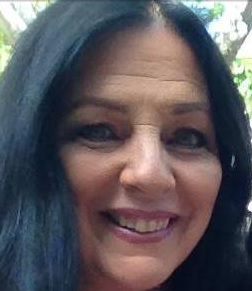



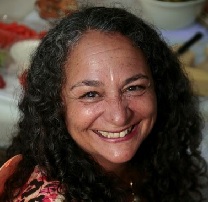
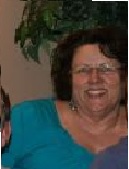


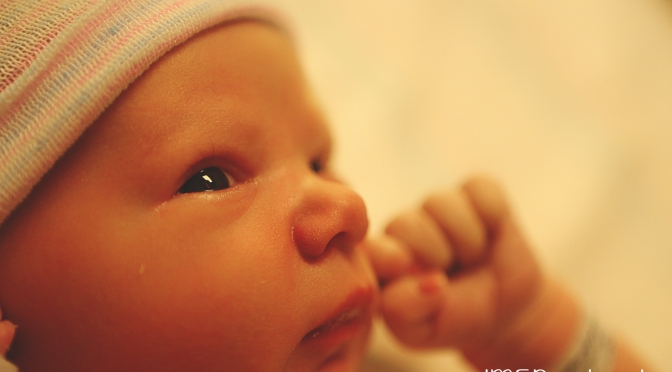

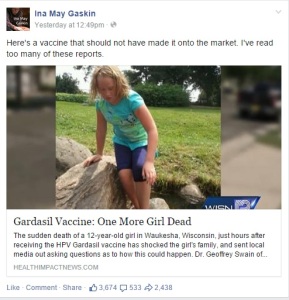
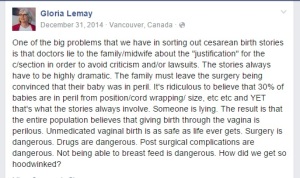

You must be logged in to post a comment.